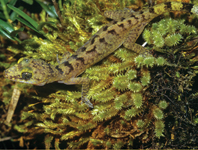Abstract
The systematics of South American Xenodontinae snakes has experienced large changes and improvements as a result of recent studies employing molecular data. Herein we assess the status of the rare Peruvian snake species, Erythrolamprus problematicus (Dipsadidae, Xenodontinae, Xenodontini), previously known from a single specimen collected in 1950. Based on new morphological and molecular data from a second specimen that we collected, we confirmed the presence of a crease in the rostral scale, mentioned in the original description (a unique trait among the Xenodontini), and recovered E. problematicus as the sister-taxon of all other Xenodontini, instead of nested among the current Erythrolamprus. Therefore, our phylogenetic results justify the erection of a new genus to accommodate the species.
References
Alfaro, M.E., Karns, D.R., Voris, H.K., Brock, C.D. & Stuart, B.L. (2007) Phylogeny, evolutionary history, and biogeography of Oriental-Australian rear-fanged water snakes (Colubroidea:Homalopsidae) inferred from mitochondrial and nuclear DNA sequences. Molecular Phylogenetics and Evolution, 46 (2008), 576–593.
https://doi.org/10.1016/j.ympev.2007.10.024
Curcio, F.F., Piacentini, V. & Fernandes, D.S. (2009) On the status of the snake genera Erythrolamprus Boie, Liophis Wagler and Lygophis Fitzinger (Serpentes, Xenodontinae). Zootaxa, 2173, 66–68.
https://doi.org/10.11646/zootaxa.2173.1.7
Dixon, J.R. (1980) The Neotropical colubrid snake genus Liophis. The generic concept. Contributions in Biology and Geology, Milwaukee Public Museum, 31, 1–40.
Grechko, V.V. (2013) The problems of molecular phylogenetics with the example of squamate reptiles; mitochondrial DNA markers. Molecular Biology, 47 (1), 61-82.
https://doi.org/10.1134/S0026893313010056
Grazziotin, F.G., Zaher, H., Murphy, R.W., Scrocchi, G., Benavides, M.A., Zhang, Y.P. & Bonatto, S.L. (2012) Molecular phylogeny of the New World Dipsadidae (Serpentes: Colubroidea): a reappraisal. Cladistics, 1 (2012), 1–23.
https://doi.org/10.1111/j.1096-0031.2012.00393.x
Jenner, J.V. & Dowling, H.G. (1985) Taxonomy of American Xenodontine snakes: the tribe Pseudoboini. Herpetologica, 41 (2), 161–172.
Katoh, K. & Standley, D. (2013) MAFFT multiple sequence alignment software version 7: improvements in performance and usability. Molecular Biology and Evolution, 30, 772–780.
https://doi.org/10.1093/molbev/mst010
Myers, C.W. (1986) An enigmatic new snake from the Peruvian Andes, with notes on the Xenodontini (Colubridae:Xenodontinae). American Museum Novitates, 2853, 1–12.
Stamatakis, A. (2014) RAxML version 8: a tool for phylogenetic analysis and post-analysis of large phylogenies. Bioinformatics, 30 (9), 1312–1313.
https://doi.org/10.1093/bioinformatics/btu033
Vidal, N., Kindl, S.G., Wong, A., & Hedges, S.B. (1999) Phylogenetic relationships of Xenodontine snakes inferred from 12S and 16S ribosomal RNA sequences. Molecular Phylogenetics and Evolution, 14 (3), 389-402.
https://doi:10.1006/mpev.1999.0717
Zaher, H. (1999) Hemipenial morphology of the South American Xenodontine snakes, with a proposal for a monophyletic Xenodontinae and a reappraisal of Colubroid hemipenes. Bulletin of the American Museum of Natural History, 240, 1–168.
Zaher, H., Grazziotin, F.G., Cadle, J.E., Murphy, R.W., Moura-Leite, J.C.de & Bonatto, S.L. (2009) Molecular phylogeny of advanced snakes (Serpentes, Caenophidia) with an emphasis on South American Xenodontines: a revised classification and descriptions of new taxa. Papéis Avulsos de Zoologia, 49, 115–153.
https://doi.org/10.1590/S0031-10492009001100001
Zaher, H., Yánez-Muñoz, M.H., Rodrigues, M.T., Graboski, R., Machado, F.A., Altamirano-Benavides, M., Bonatto, S.L. & Grazziotin, F.G. (2018) Origin and hidden diversity within the poorly known Galápagos snake radiation (Serpentes: Dipsadidae). Systematics and biodiversity, 16 (7), 614–642.
https://doi.org/10.1080/14772000.2018.1478910

